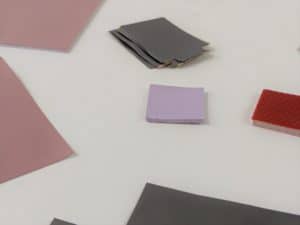At NEDC, we manufacture many different thermal pads. The most common type we see is silicone-based thermal pads. One of the things I always say is, thermal pads are like ice cream. They come in hundreds of different flavors. When I say flavors, I mean compositions, thicknesses, colors, reinforcements, etc. But similar to how there is frozen yogurt, and ice cream, there are different make-ups of thermal pads achieving the same goal but different requirements are placed on each application.
The ultimate goal of thermal pads is to provide thermal conductivity to remove heat out of the application. However, sometimes they are also used as electrical insulators. Other times, that quality is not that important. In addition, some are thinner, others thicker depending on the gap requirements.

Thermal Pads
Why Different Types of Thermal Pads?
We have all heard of the insidious affects silicone can present in some applications. However, it is good to point out that in most applications silicone-based thermal pads can be acceptable. Silicone bleeding and out-gassing can become a concern depending on the application. We thought it may be a good idea to write a blog about the different thermal pads available. In addition, sometimes there are benefits to alternatives such as graphite-based that silicone-based just cannot achieve. For example, oftentimes graphite-based thermal pads have significantly higher levels of thermal conductivity.
Silicone-Based Thermal Pads
Out of all the thermal pads on the market, silicone-based thermal pads represent a significant amount of them. This is for a few reasons. First, silicone offers the ability to easily be filled with different types of fillers. Second, silicone has a wide temperature range. Third, silicone is inherently electrically insulative. Many thermal pads are insulative because of the places they are going require electrical insulation to prevent shorts. Silicone based pads are found in both thin gaps, and thicker gap situations.
Graphite-Based Thermal Pads
Graphite-Based Pads are not as common as silicone based pads. It is important to note, that some- not all, graphite based pads have silicone in them. However, graphite based pads benefits can offset the lack of electrical insulation that is oftentimes present. For example, thermal conductivity is usually much higher in both X, Y, and Z directions. Graphite based thermal pads are found in both thin gaps, and thicker gap situations.
Acrylic-Based Thermal Pads
For acrylic-based pads, one of the major selling points is the fact they usually do not contain silicone. As most engineering groups are aware, silicone can sometimes have insidious effects in applications due to outgassing, and oil-bleeding. However, similar to silicone-based thermal pads they typically are electrically insulating, and offer a competitive thermal conductivity profile. These pads are usually used in thicker gap filling situations.
Polyester-Based Thermal Pads
Usually polyester based thermal pads are on the thinner side. These thermal pads can offer a great alternative to silicone-based thinner pads designed for higher pressure applications. However, it is good to keep in mind, the temperature requires are not nearly as capable as their silicone based companions. These pads usually range from .020’’ to .005’’ in thickness.
Die Cutting Thermal Pads
NEDC die-cuts, or otherwise converts thermal interface materials into thermal pads for different applications. For more information on thermal pads, or you believe you have an application that requires a thermal pad, please contact sales@nedc.com.